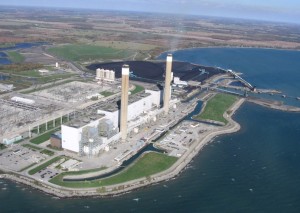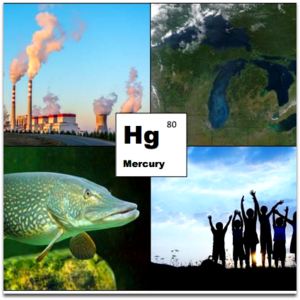– Since Turn Of This Century, Levels Of Toxic Mercury Have Increased In Great Lakes Fish
News from the Canada/U.S. International Joint Commission
December 2015
(A Brief Foreword to this News from Niagara At Large publisher Doug Draper –
Mercury, as many of you may know, can do terrible damage to the health of people and other livings beings if it is allowed to accumulate in fish and other wildlife on up the foodchain to people in high enough concenrations.

Tests on Perch in Lake Erie and other parts of the Great Lakes have recently shown levels of mercury rising once again in their flesh. Consult fish consumption guidelines available online in Ontario, New York State and other jurisdictions on guidance on how much Great Lakes fish is safe to consume.
That is why Canadian and U.S. federal, provincial and state governments, working with the binantional International Joint Commission, have been monitoring concentrations of mercury in the Great Lakes ecosystem for more than four decades and have put policies in place through that time that have been aimed at reducing and eliminating the release of mercury from a host of courses, including coal-burning electrical power plants.
These measures by Canadian and U.S. governments have resulted in declines in mercury levels in the Great Lakes during the 1970, 80s and in to the 90s. However, atmospheric monitoring by Environment Canada and the U.S. Environmental Protection Agency has tracked mercury reaching North America from other regions around the world, including China, where coal and other fossil fuels remain in massive use.
Once here, the Great Lakes serve as a giant sink for mercury and other airborne poisons from countries far away. This is one of the reasons why, even if you still have doubts about pollution from human activities altering the earth’s climate, it is still vitally important to move toward zero use of fossil fuels that emit these hazardous pollutants.
Now please read the following report on this issue from the International Joint Commission.)
From the IJC – Mercury levels in Great Lakes fish declined significantly through the 1970s and ‘80s; atmospheric mercury emissions from the United States declined by about 60 percent between 1990 and 2005, while Canada emissions decreased about 85 percent between 1990 and 2010. This was in part due to closures of coal-fired power plants in Canada and the U.S.
In spite of these exemplary achievements, mercury levels have increased in some Great Lakes fish species in the 2000s. So what happened?
China and other Asian countries posted the most significant increases in mercury emissions from 1990 to 2010, largely due to increases in coal-fired power plants. Thus, in spite of regional progress to reduce emissions, increased mercury loadings reaching the Great Lakes through long-range atmospheric transport may be offsetting emission declines in North America.

This coal-fired plant, along the shores of Lake Erie in Ontario, and others in the province are now shut down due to long-standing concerns about air pollution from their operations.
Canada and the U.S. have already proven that reductions in mercury emissions are important and possible. The province of Ontario, Canada, is the first jurisdiction with a significant reliance on coal in North America to eliminate all coal-fired electricity.
Given the severe health effects caused by exposure to mercury, addressing mercury pollution that originates outside of North America is essential to the health of the Great Lakes ecosystem and the people living in it. The IJC’s key recommendation for governments to address atmospheric deposition of mercury is to provide funding for a monitoring network that would allow scientists to methodically trace the sources and trends of mercury pollution inside and outside of the Great Lakes basin.
The IJC recommends monitoring stations such as this wet deposition sampler at the Kellogg Biological Station in Michigan to track atmospheric deposition of mercury. Credit: Lake Michigan Air Directors Consortium, 2013
Atmospheric transport and deposition of toxic chemicals are at the forefront of environmental challenges facing the Great Lakes basin. Monitoring toxic inputs of substances such as mercury will be crucial to developing policies to protect the Lakes and its residents.
World leaders gathered in Paris this month to try to reach a fossil fuels emissions deal that would help with some of this airborne pollution. To have truly healthy Great Lakes, we need global action.
Following the adoption of regulatory measures in the 1970s, studies showed a gradual reduction in mercury contamination in fish in the Great Lakes. However, this trend reversed in the 1990s.
This is what Environment Canada scientists have observed based on their analysis of data collected over the past 35 years on fish contamination in Lake Erie. Mercury concentrations appear to have either stopped decreasing or begun increasing in most species under study, including Walleye, Smallmouth Bass, Yellow Perch and White Bass. While the cause of this reversal remains unclear, scientists have proposed several hypotheses, including changes within the food chain relating to the introduction of invasive exotic species.
However, scientists for some time have understood that toxic pollution also can be airborne, and released on distant continents before traveling thousands of miles and kilometers through the atmosphere and landing in the Great Lakes basin. A growing proportion of toxic pollution entering the Great Lakes is transported through this process, called long-range atmospheric transport. As a result, regional efforts to decrease emissions of toxic substances, while important, may not be enough to halt the increasing levels of toxic pollution found in the lakes.
Some Background –
The Great Lakes Water Quality Agreement – a binding document that guides the International Joint Commission — stipulates that human consumption of fish should be “unrestricted by concerns due to harmful pollutants.” In this area, the IJC is particularly concerned about the atmospheric deposition of one toxic substance: Mercury.
Bacteria present in sediments can convert mercury into a toxic substance called methylmercury. Methylmercury increases in concentration in fish as it moves up the food chain in a process called bioaccumulation. When humans consume the contaminated fish, they are at risk for a number of serious health problems.
Infants and children are at particular risk when exposed to methylmercury. Children of women who eat large amounts of contaminated fish during their pregnancies may suffer impaired neurological development or cognitive impacts to memory, attention, language, and fine motor and visual spatial skills.
Mercury levels in Great Lakes fish declined significantly through the 1970s and ‘80s; atmospheric mercury emissions from the United States declined by about 60 percent between 1990 and 2005, while Canada emissions decreased about 85 percent between 1990 and 2010. This was in part due to closures of coal-fired power plants in Canada and the U.S.
In spite of these exemplary achievements, mercury levels have increased in some Great Lakes fish species in the 2000s. So what happened?
China and other Asian countries posted the most significant increases in mercury emissions from 1990 to 2010, largely due to increases in coal-fired power plants. Thus, in spite of regional progress to reduce emissions, increased mercury loadings reaching the Great Lakes through long-range atmospheric transport may be offsetting emission declines in North America.
Canada and the U.S. have already proven that reductions in mercury emissions are important and possible. The province of Ontario, Canada, is the first jurisdiction with a significant reliance on coal in North America to eliminate all coal-fired electricity.
Given the severe health effects caused by exposure to mercury, addressing mercury pollution that originates outside of North America is essential to the health of the Great Lakes ecosystem and the people living in it. The IJC’s key recommendation for governments to address atmospheric deposition of mercury is to provide funding for a monitoring network that would allow scientists to methodically trace the sources and trends of mercury pollution inside and outside of the Great Lakes basin.
The IJC recommends monitoring stations such as this wet deposition sampler at the Kellogg Biological Station in Michigan to track atmospheric deposition of mercury. Credit: Lake Michigan Air Directors Consortium, 2013
Atmospheric transport and deposition of toxic chemicals are at the forefront of environmental challenges facing the Great Lakes basin. Monitoring toxic inputs of substances such as mercury will be crucial to developing policies to protect the Lakes and its residents.
World leaders are in Paris this month to try to reach a fossil fuels emissions deal that would help with some of this airborne pollution. To have truly healthy Great Lakes, we need global action.
– See more on this issue at: http://www.ijc.org/en_/blog/2015/12/08/reducing_great_lakes_mercury_contamination/?utm_source=IJC+Newsletter+Subscribers&utm_campaign=84826d2c26-IJC_Newsletter_Sept_8_2015&utm_medium=email&utm_term=0_e942718880-84826d2c26-323273345#sthash.FLP7Gize.dpuf
Role of the Internation Joint Commission –
Canada and the United States created the International Joint Commission because they recognized that each country is affected by the other’s actions in lake and river systems along the border. The two countries cooperate to manage these waters wisely and to protect them for the benefit of today’s citizens and future generations.
The IJC is guided by the Boundary Waters Treaty, signed by Canada and the United States in 1909. The treaty provides general principles, rather than detailed prescriptions, for preventing and resolving disputes over waters shared between the two countries and for settling other transboundary issues. The specific application of these principles is decided on a case-by-case basis.
The IJC has two main responsibilities: regulating shared water uses and investigating transboundary issues and recommending solutions.
The IJC’s recommendations and decisions take into account the needs of a wide range of water uses, including drinking water, commercial shipping, hydroelectric power generation, agriculture, industry, fishing, recreational boating and shoreline property.
– Learn more about the International Joint Commission and its work by clicking on – http://www.ijc.org/en_/ .
NOW IT IS YOUR TURN. Niagara At Large encourages you to share your views on this post. A reminder that we only post comments by individuals who share their first and last name with them.
Visit Niagara At Large at www.niagaraatlarge.com for more news and commentary for and from the greater bi-national Niagara region.

Will we be able to keep up with the new light bulbs that get dumped into the garbage and eventually release their mercury to work its way into the water system? Dumbest move our government has made in a long time (well, not so long time) was to force people to change over to the mercury charged light sources. The right hand does not know what the left is doing!!
LikeLike